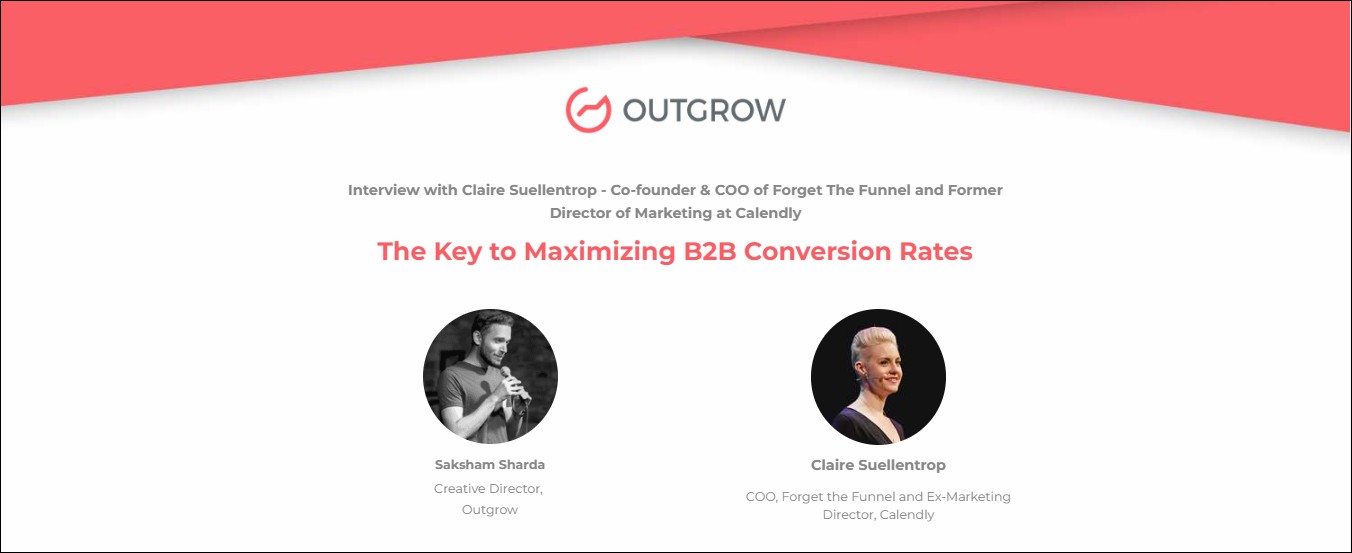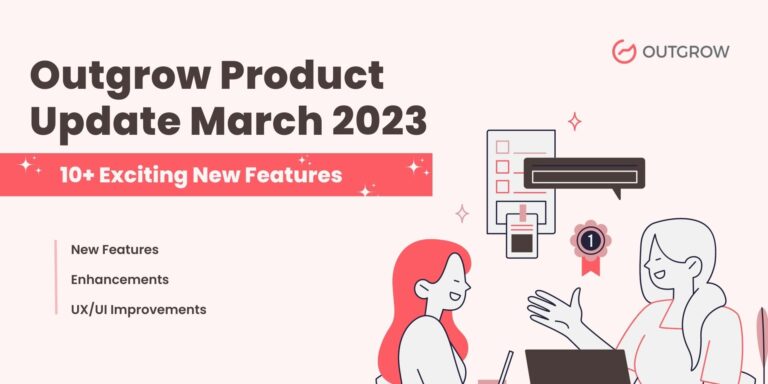Hey there! Welcome to the Marketer Of The Month blog!

We recently interviewed Claire Suellentrop for our monthly podcast – ‘Marketer of the Month’! We had some amazing insightful conversations with Claire and here’s what we discussed about-
1. The 3 most critical skill positions for leading a SaaS marketing team
2. The key difference between Marketing and Growth
3. Leveraging ideal customers in product-led growth
4. Marketing channels you need to perfect your messaging
5. How to provide value to customers that have the intent to purchase
6. How to use performance indicators in 2022: Distinguishing CPIs from KPIs
About Our Host:
Dr. Saksham Sharda is the Chief Information Officer at Outgrow.co He specializes in data collection, analysis, filtering, and transfer by the means of widgets and applets. Interactive, cultural, and trending widgets designed by him have been featured on TrendHunter, Alibaba, ProductHunt, New York Marketing Association, FactoryBerlin, Digimarcon Silicon Valley, and at The European Affiliate Summit.
About Our Guest:
With an experience of more than 10 years in marketing and 8 years in SaaS – Claire Suellentrop is on a quest to democratize access to fulfilling, high-paying careers in tech. Previously the Director of Marketing and #2 employee at Calendly — she has seen firsthand that truly effective marketing stems from a deep understanding of existing customers. Tune in to know how her methods have helped businesses identify marketing messages that build greater relationships and achieve record-breaking sales.
The Key to Maximizing B2B Conversion Rate
Table of Contents
The Intro!
Saksham Sharda:
Hi, everyone. Welcome to another episode of outgrows marketer of the month. I’m your host, Dr. Saksham Sharda. I’m the creative director at outgrow.co And for this month, we are going to interview Claire Suellentrop who is the co-founder and COO at Forget The Funnel. Thanks for joining us, Claire.
Claire Suellentrop:
Absolutely. Thanks for having me.
Don’t have time to read? No problem, just watch the Podcast!
Or you can just listen to it on Spotify
The Rapid Fire Round!

Saksham Sharda:
So, Claire, we are going to start with a rapid-fire round just to break the ice. You get three passes in case you don’t want to answer a question, you can just say pass, but try to keep your answers to one word or one sentence only. Okay?
Claire Suellentrop:
Okay. Let’s do it.
Saksham Sharda:
All right. So the first one, Godfather or Star Wars?
Claire Suellentrop:
Godfather
Saksham Sharda:
How many hours of sleep do you need to function?
Claire Suellentrop:
At least seven.
Saksham Sharda:
What’s your favorite carb bread, pasta, rice, or potatoes?
Claire Suellentrop:
I’d have to say bread. That’s a good one though.
Saksham Sharda:
Most embarrassing moment of your life.
Claire Suellentrop:
All of the high school’s.
Saksham Sharda:
Okay. Cringe. What do the acronyms Kuba stand for?
Claire Suellentrop:
I have no idea. Pass
Saksham Sharda:
Okay. What’s your ideal outside temperature?
Claire Suellentrop:
Oh, about 75 Fahrenheit.
Saksham Sharda:
Okay. And if everyone in the world had to get married, when they reached a certain age, what would that age be?
Claire Suellentrop:
Old as possible.
Saksham Sharda:
Okay. Favorite type of muffin?
Claire Suellentrop:
Chocolate.
Saksham Sharda:
The city in which the best kiss of your life happened?
Claire Suellentrop:
What a good question! Probably New York.
Saksham Sharda:
Okay. The first movie that comes to your mind when I say the word “ambition”?
Claire Suellentrop:
What is that? What’s the always be a closing movie. I can’t remember the name.
Saksham Sharda:
Okay, we’re just gonna leave it there.
Saksham Sharda:
A habit of yours that you hate?
Claire Suellentrop:
Probably how often I say “Umm”
Saksham Sharda:
Your favorite Netflix show?
Claire Suellentrop:
Tuca and Bertie
Saksham Sharda:
Just went, “umm” again, so I was just like, okay. That’s too soon after the previous question, but yes, that was the end of the rapid-fire round. You had two passes, I think, or two places where you didn’t quite answer, which means that you score eight and 10, which means you only win a car. Just kidding. You don’t win anything.
The Big Questions!

Saksham Sharda:
All right. So the long-form questions, the first one is what are the different skill positions on your marketing team? What advertising platforms and target audiences have you found to be the most effective for SaaS?
Claire Suellentrop:
Wow, fantastic. So I’ll try to break those down. So what are the skills of our marketing team?
Saksham Sharda:
Yeah. Different skill positions on your marketing team.
Claire Suellentrop:
So our marketing team is pretty small. Our company overall is about well, myself and my co-founder full time and by full time we do a four day work week. So four days a week, and then the rest of our team is very flex. Overall though we are about seven people and at any given time, I’d say probably about three of us are working on marketing. So our core skill sets are strategic planning, for sure. So we take a very customer-led approach to everything we do. So like customer research and insights gathering is a key skillset that’s important to us. And then strategy development from gathering those insights is really important. And then in terms of marketing, I guess, channels or expertise on the actual demand side,co-marketing so like partnerships are a major play for us. That’s a major skill set, email marketing, and automation is a major skill set for us. And then I guess thought leadership is probably the best way to phrase, our third most important skillset. In other words, having an opinion about how marketing should run and being vocal about that opinion is probably our biggest third skill set. In terms of platforms that we’ve seen work for SaaS companies, this is such a, it’s gonna be annoying “it depends on question” right? Because it’s going to entirely depend on who the target audience of that SaaS platform is. So some companies our team works with us were SaaS consulting firms just for helpful context. We’ve worked with folks who run SaaS companies that target heavily B2B enterprise customers for them, something like LinkedIn advertising is going to be probably the most effective leveraging tools like ad role of course are going to be important. But what they’re advertising is gonna be just as important, right? So oftentimes what we are helping them do is not just identify what channels will be most effective, but also what messaging is most effective so that might be a good outlet for again someone targeting enterprise customers, B2B space in other situations for companies targeting more self serve customers and are who are going for a more high volume play you know paid advertising isn’t necessarily always gonna be what scales forever. In those cases, sponsoring podcasts that their customers listen to or appearing in newsletters is going to be more effective. So it really depends on the customer you’re trying to serve and where they go to look for new solutions as much as your product and your pricing model. So I recognize that’s not a super flat answer, but hopefully, it was helpful.
Saksham Sharda:
And speaking of thought leadership, then your title is SaaS marketing and growth advisor. Is there a distinction between growth marketing and marketing in general, isn’t all marketing about growth.
Claire Suellentrop:
That’s a fantastic question. I would agree with you that marketing is all about growth. There really isn’t a differentiation between growth and marketing, but we have learned that our target audience, which is founders and execs within SaaS companies do sometimes look at them as different practices. So a lot of, SaaS founders, when we first start speaking with them, they think of marketing as like brand awareness and they think of growth as more of the metrics, more of the spreadsheet type marketing. So we use growth and marketing advisor because that’s the messaging that we’ve found resonates with, who we are trying to target, and who we speak to, even though yes, internally, I would agree with you 100% that it’s all the same.
Saksham Sharda:
And so when it comes to growth strategies of all sorts if a company follows a product-led growth strategy, how can it transform customers into promoters?
Claire Suellentrop:
Super good. How can they transform customers into promoters? Well, how much time do we have?
Saksham Sharda:
Well, you can keep talking. It’s fine. There’s no, there’s no limit.
Claire Suellentrop:
So there’s actually a very specific process. We follow to help companies as companies with a product-led approach do exactly that. So, the general high-level steps are first identifying within their current customer base, who are those current best customers who already love their product and would happily promote it to others. Typically we’ve categorized those customers by one they’re highly engaged. So they’re using the product on an ongoing basis and getting value and they’ve become customers. In other words, they’ve started paying within the past six months to a year, because we want to identify customers who purchased recently and are gonna remember what their buying journey was like. So identifying their best customers is step 1, to do that. Step 2 is actually learning from those customers via interviews and surveys. We have a very specific survey that we typically use not just, you know, what they like about the product, which is helpful information, but what led them to seek out a new solution like this product.
So for example we just started working with a company that offers a very product-led solution. It’s a meditation app, right? Very consumer-focused. There are no sales involved, it’s all product-led and even though they’re a pretty small name, they have thousands of paying customers in a market that’s very saturated, those other much bigger brands of meditation apps out there. So when we start working together, the first thing we will look to uncover from their customers is why this one over any others? Why this one over Headspace, why this one over calm? What led you to seek out and finally choose this particular product. So in doing that, identifying the best customers, and learning why they bought we can then understand what makes this product competitive and superior to others in this space, in the eyes of best customers, not internally what we think their competitive differentiators are, but what do their customers say they are?
And when we do that, we can then zoom out and kind of put ourselves in the shoes of those best customers and walk through their customer buying journey. So we can use products like spark Toro. It’s an audience research tool to go to the sources where their target customers spend time and listen to the podcast. They listen to watch YouTube channels. They watch and read the blogs they read, and then we can go to the product website or in this case, the app store, and knowing what customers said was really valuable. We can see, Hey, does this company actually promote those most important features on their site? Do they highlight their competitive differentiators in a way that matches what their customers say? And if not, then we see opportunities to improve messaging, and positioning, and then we get into the product itself, right? So we sign up and we look around and we say, okay, is it easy to find the things that customers said were most important within this product? Are there opportunities to make that onboarding experience and getting to the “aha” moment easier? And then finally, naturally once, once we’ve gone all the way through the customer journey, to the moment where they receive value, then we’re looking at, Hey, are we, is this company proactively asking those ideal customers to leave a five-star review? Are we asking customers to spread the word to a friend? Are we asking customers, Hey, who do you know, who might love this meditation app as well? So there are, I guess I laid out, three of the steps there, identify your best customers, learn why they bought, and understand where the opportunities are to better leverage those best customers. And then of course, of course, the fourth is to implement the plan, right. Actually leverage that as those ideal customers as a growth channel both by asking them to leave reviews, asking them to refer friends, but also by taking their words and applying customers’ language to the products, messaging, and positioning to better attract more people like them. So that was my kind of roundabout way of leveraging ideal customers in product leg growth.
Saksham Sharda:
So besides SparkToro, what other marketing channels or tools do you think one needs to perfect in order to send the right message to the right person at the right time?
Claire Suellentrop:
Yeah. Really, I don’t wanna sound like a broken record, but it always, it always depends on what we hear from those ideal customers and that’s always a little bit different. So in the B2B space, the channels that we often see are most effective, we already chatted about LinkedIn but then any type of industry news sources publications existing thought leaders and partnering with existing thought leaders in those spaces is very effective. So on the other end of the spectrum, if we’re on the heavy consumer side really common channels like Instagram ads or other social media ads can work to an extent. We are seeing though that the biggest most saturated channels only scale so far and then you really do need as a company to start relying on channels, more like partnership marketing, right?
So find other brands or influencers in your audience’s space that already have their attention leveraging, not just YouTube ads, but partnership creating partner content. So really, I guess if I had to summarize it, it’s not just paid channels like LinkedIn or other consumer social platforms, but it’s also content marketing itself. That’s really even though content marketing has been a concept that’s been around for decades, it’s something that’s clearly still not going away, and the more a company can understand what existing content creators its customers love and the more it can establish partnerships with those creators the more likely you are to reach and resonate with your audience.
Saksham Sharda:
And so once you have this top-of-the-funnel traffic, how can you deliver value to those that have the intent of like, you know, finally buying your product to service?
Claire Suellentrop:
I think it depends on how long or short your ideal customer’s buying journey is. So, as an example, again, speaking to the product-led approach I recently bought a treadmill for under my desk. I do a lot of sitting as many of us do who work in tech and of course, it’s a smart treadmill and it comes with an app when I purchased the treadmill and downloaded the app my journey to getting value was super short. All the app had to do was turn on the treadmill and help me adjust my speed, done! Pretty short buying journey. So there wasn’t a lot that the company needed to do in terms of onboarding. It was very straightforward, very much, unlike, let’s say onboarding into a new project management software or onboarding into a new, what else is a highly complex thing to do.
Claire Suellentrop:
A new marketing automation tool migrating from an old marketing automation tool to a new one. What those types of companies are going to need to do to provide value is much more complex and will probably require several different steps. So the first indication that their customers might be getting value is that they’re seeing an increase of not just traffic to their site but also an increase in visits to signups for their free or their trial product that would indicate that they’ve reached a point in their positioning in messaging at which they’re resonating with the pain that their ideal customers feel and actually conveying that, yes, we can help solve this pain. So that’d be one way of assessing whether or not they’re creating value is that they’re hitting customers with the right message. And then next stage would be once free users have gotten inside of their product. What is the first moment that not just the customer took a step, but that they actually saw in their own life, okay, Hey, this product will work for me. I’m trying to think of a good example of that. A great example in my many years ago now my final in-house role was as the number two hire and the director of marketing at Calmly. Someone signing up for a Calmly account would begin with putting in their email address and connecting the product to their calendar but that doesn’t inherently mean that the new user got value. Having a scheduling tool connected to your calendar doesn’t provide value in that itself. The product wasn’t actually valuable to someone until they had their first meeting scheduled through it. So we tracked product activation, not by someone signing up and connecting their calendar, but by someone signing up connecting their calendar and getting their first meeting scheduled. So looking at that moment based on when your customers say they understood the value is how you’ll be able to track that it’s always different based on what your product is and what your customers say the moment of value was. So that’s where, when I mentioned earlier that we’re customer-led, that’s where that customer-centricity comes in by evaluating your internal measure measurements based on what your customers say was valuable.
Saksham Sharda:
So to sum it all up, to what extent would you say that the more your company’s attention is focused on outcomes, important to your customers, the CPIs, the better your company will likely perform on outcomes important to the business KPIs.
Claire Suellentrop:
100%. That was the perfect story.
Saksham Sharda:
What are you gonna disagree with it? I know you 100% agree with it, but what would be the flip side, if you had to, what would be the drawbacks? What would be the hypothetical argument against a sentence
Claire Suellentrop:
An argument against being customer-centric? Is that right?
Saksham Sharda:
Yeah. Well just as a thought experiment even though you don’t believe in that.
Claire Suellentrop:
Yeah. Let me think through that. Well, this isn’t necessarily an argument against it, but I can describe what we do often see happen out in the real world, which is when we start working with companies, typically the KPIs that they’ve used to define their internal success were defined kind of based on guesses kind of based on this is what we think will move the needle for our product and our company, but we don’t really know. So I would say that well-intentioned guesses are probably the opposite end of the spectrum from customer-led KPIs for example, it’s super common for us to start working with a team in which they have a, they have someone responsible for the traffic. They have someone responsible for MQLs and then maybe SQLs or PQLs and so on because that’s what they’ve been told they’re supposed to be measuring, but oftentimes even though they say, okay, we track MQLs and then SQLs it’s common for us to then ask teams. Okay. How do you define an MQL versus an SQL? Different teams will have different definitions for people within the company. Sometimes don’t actually have a formal definition. So well-intentioned guesses are problematic one because people don’t really know how to then impact those, those metrics, and two, because they can actually cause some tension between teams, if marketing is defining MQL the same way that sales is defining an SQL it creates tension, creates infighting. It creates confusion versus measuring the team’s success based on what defines customer success. Zo again, that’s not necessarily an argument against being customer-led, but it is what often happens when a company is young and still figuring out what KPIs even matter.
Saksham Sharda:
Okay. So the last question is leaving all customers and KPIs, aside, what would you be doing if not this in your life right now?
Claire Suellentrop:
Wow, that’s amazing. What would I be doing? I would be doing something outside. So my brother-in-law, for example, works in landscaping and gardening. He’s outside in nature all day long and he really loves that. In my spare time have a bunch of flowers, all around our house, I tend to be out in the world versus being in tech and on the computer. It’s like the different ends of the work spectrum. So in my day, life is all about being on devices. If I weren’t doing this, I would be 100% off of devices.
Saksham Sharda:
Okay. Fair. That’s all. That’s the one thing everyone wants to do in the post-pandemic freedom that we are gonna get, hopefully.
Let’s Conclude!
Saksham Sharda:
Well, thanks to everyone for joining us for this month’s episode of Outgrow’s Marketer Of The Month. That was Claire Suellentrop, who’s the co-founder and COO at Forget the Funnel. Thanks for joining us, Claire.
Claire Suellentrop:
Thank you so much for having me.
Saksham Sharda:
Check out the website for more details, and we’ll see you once again next month with another Marketer of the Month.

Tanya is a Content Writer and Marketer at Outgrow. She is self-driven and loves being creative and learning new things. When she is not working, she enjoys watching movies and web series.




